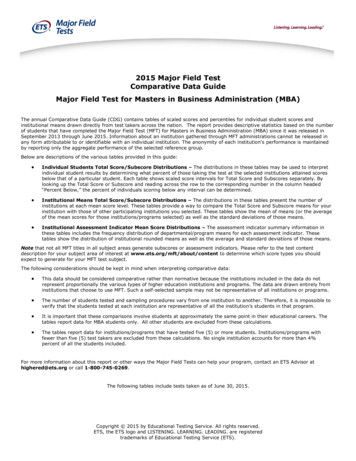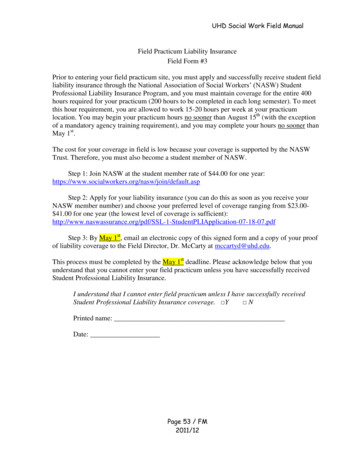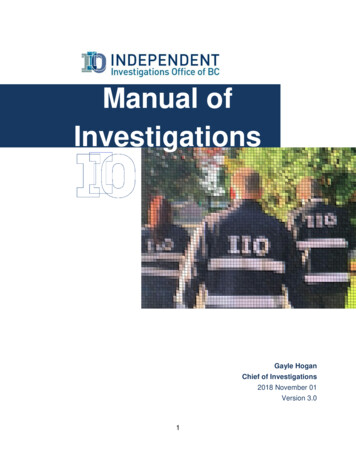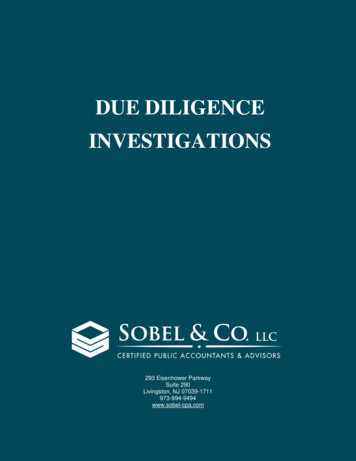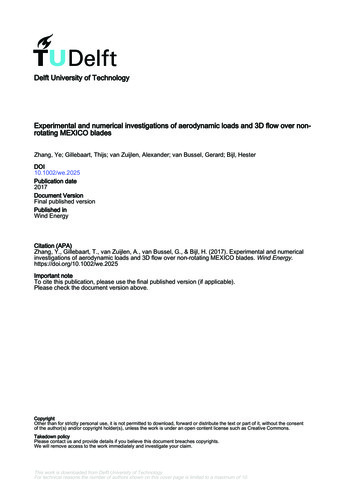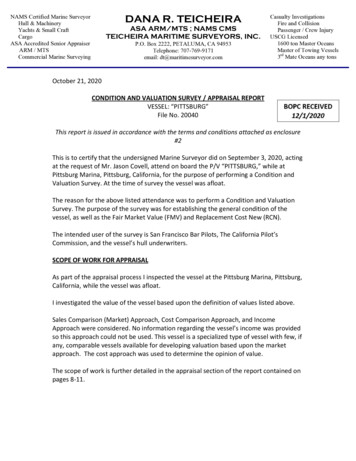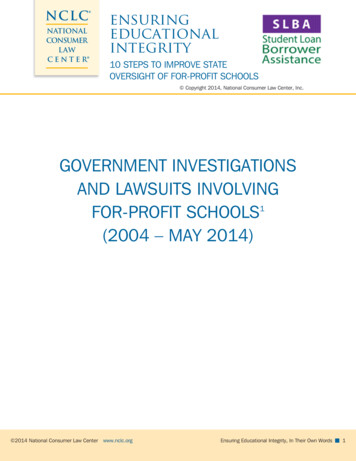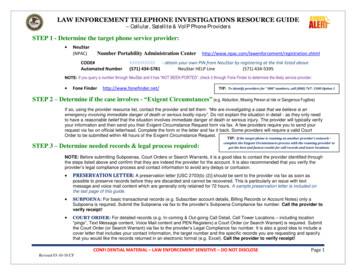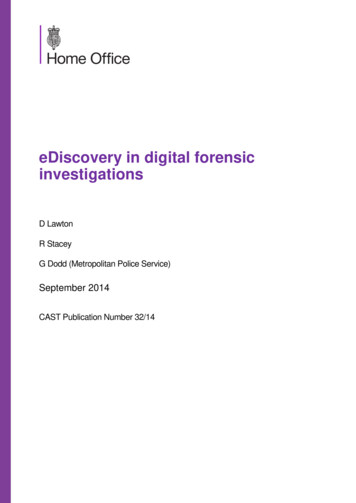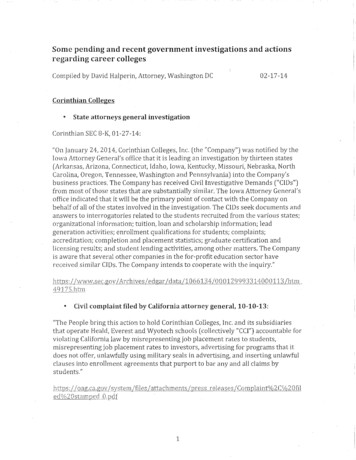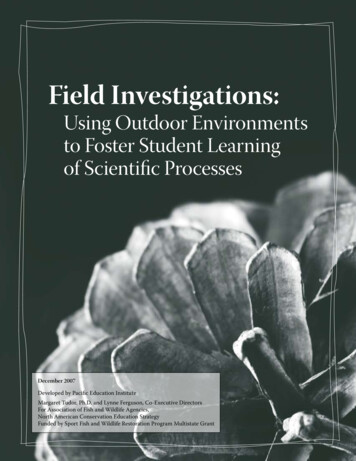
Transcription
Field Investigations: Using Outdoor Environments to Foster Student Learning of Scientific ProcessesField Investigations:Using Outdoor Environmentsto Foster Student Learningof Scientific ProcessesDecember 2007Developed by Pacific Education InstituteMargaret Tudor, Ph.D. and Lynne Ferguson, Co-Executive DirectorsFor Association of Fish and Wildlife Agencies,North American Conservation Education StrategyFunded by Sport Fish and Wildlife Restoration Program Multistate Grant
Field Investigations: Using Outdoor Environments to Foster Student Learning of Scientific Processes
Field Investigations: Using Outdoor Environments to Foster Student Learning of Scientific ProcessesField Investigations:Using Outdoor Environmentsto Foster Student Learningof Scientific ProcessesDeveloped ByPacific Education InstituteMargaret Tudor, Ph.D.Lynne FergusonCo-Executive DirectorsDeveloped forAssociation of Fish andWildlife Agencies’North AmericanConservation EducationStrategyFunded by aMultistate Grant of theSport Fish and WildlifeRestoration ProgramDecember 2007AuthorsAmy E. Ryken, Ph.D., University of Puget Sound, Tacoma, WAPatricia Otto, Pacific Education Institute, Olympia, WAKayleen Pritchard, Pacific Education Institute, Olympia, WAKatie Owens, Orchard Center Elementary School, Spokane, WA
Field Investigations: Using Outdoor Environments to Foster Student Learning of Scientific Processes
Field Investigations: Using Outdoor Environments to Foster Student Learning of Scientific ProcessesPrefaceThis volume—Field Investigations: Using Outdoor Environments to Foster Student Learning of ScientificProcesses—was developed to help K-12 teachers introduce their students to the methodologiesused for scientific field research and guide them through the process of conducting field studies. Inparticular, this volume demonstrates how to use descriptive and comparative methodologies for fieldstudies.Scientific inquiry is essential to the study of the natural world and the environmental issues thatcurrently confront society. To identify the key methodologies employed by professional researchersfor field science inquiry, the Pacific Education Institute (PEI) conducted a nationwide study. Fromthe results of this study, PEI, a public-private consortium of natural resource and education agenciesand organizations, developed the field investigation methodologies presented in this publication.These inquiry methodologies thus reflect the contemporary inquiry processes used by practicing fieldbiologists in fish, wildlife habitat, forests and water related studies.The Association of Fish and Wildlife Agencies (AFWA) engaged the Pacific Education Institute toprovide the field investigation guidelines for teachers to help them implement meaningful scienceinquiry with their students. The guidelines fulfill expectations of the K-12 plan for the North AmericanConservation Strategy, funded by a Multistate Grant of the Sport Fish and Wildlife RestorationProgram.Margaret Tudor, Ph.D.Executive DirectorPacific Education InstituteLynne FergusonExecutive DirectorPacific Education InstituteAcknowledgementsEducation should prepare both students and the public to understand the natural resources onwhich we all depend. It should also provide opportunities for students and other citizen scientists toinvestigate natural resource concerns and make meaningful contributions to our understanding ofthe natural environment. The guidelines for Field Investigations was developed to help facilitate thiscritical advance in education. For its creation and publication, we are especially indebted to those atthe Washington State Department of Fish and Wildlife who recognized that an informed and engagedpublic is critical to the mission of natural resource agencies and who therefore championed thisseminal education project: Dr. Jeff Koenings, Director of the Washington Department of Fish andWildlife (WDFW), John Pierce, Chief Wildlife Scientist, Richard “Rocky” Beach, Wildlife Division, andMichael O’Malley, Watchable Wildlife Program.Also special thanks to the Washington Forest Protection Association (WFPA) Executive DirectorMark Doumit, and chair of the WFPA Environmental Education Committee Norm Schaaf, for theiron-going support of the work of the Pacific Education Institute.
Field Investigations: Using Outdoor Environments to Foster Student Learning of Scientific ProcessesContributorsMichael Clapp, CAM Junior High School, Battle Ground, WAKaren Dvornich, Fish and Wildlife Cooperative Research Unit, University of Washington, Seattle, WATrish Griswold, Teacher, Walter Strom Middle School, Cle-Elum, WADr. Gary Koehler, Wildlife Biologist, Washington Department of Fish and WildlifeDiane Petersen, Teacher, Waterville Elementary, WADr. Peter Ritson, Science Programs, Washington State University, Vancouver, WAAdvisorsDan Burgard, PhD., Assistant Professor of Chemistry, University of Puget Sound, Tacoma, WALynne Ferguson, Co-Executive Director, Pacific Education Institute, Olympia, WASusan Keene, Teacher, Arlington Elementary, Tacoma, WAMary Kokich, Teacher, Pt. Defiance Elementary School, Tacoma, WAIzi Loveluck, Teacher, Edgehill Elementary, British Columbia, CanadaMary Moore, Teacher, Lewis and Clark Elementary, Richland, WAKate Poaster, Science Instructor, Issaquah School District, Issaquah, WADave Reynolds, Teacher, Cedar River Middle School, Tahoma, WAEllen Saltsman, Teacher, Loyal Heights Elementary, Seattle, WAKathryn Show, Science Curriculum Specialist, Seattle, WALinda Talman, Teacher, Conway Middle School, Mount Vernon, WAJane Ulrich, Teacher, Sunny Hills Elementary, Issaquah, WAStacey Weiss, Assistant Professor of Biology, University of Puget Sound, Tacoma, WAField Investigation Model Development Panel:Edoh Amiran, PhD.; Math Department, Western Washington University – Math modeling forecological investigationsJonas Cox, PhD.; Science Education Gonzaga UniversityGary Koehler, PhD.; Wildlife Biologist. Washington Department of Fish and WildlifeMartha Kurtz, PhD.; Integrated Science Education, Central Washington UniversityTimothy Nyerges, PhD.; Department of Geography, University of WashingtonEthan Smith, Teacher, Tahoma Senior High School, Covington, WAMargaret Tudor, PhD.; Co-Executive Director Pacific Education InstituteDawn Wakeley, Curriculum Specialist, Tahoma, WAMark Windschitl, PhD.; Science Inquiry Expert; School of Education, University of WashingtonEric Wuersten, Science Curriculum Supervisor, Washington State, OSPISpecial thanks to all the teachers who have participatedin workshops and shared their insights.
Field Investigations: Using Outdoor Environments to Foster Student Learning of Scientific ProcessesTable of ContentsSection 1: Field Investigations as Inquiry: A Conceptual Framework.1Section 2: Preparing Students to Conduct Field Investigations.7Part 1: What Questions Can I Investigate?. 8Part 2: Descriptive Field Investigation: What Plants and Animals Use theSchoolyard Habitat?. 15Part 3: Comparative Field Investigation: How Does Surface Temperature VaryWith Location?. 22Section 3: Building Field Investigations from Student Questions.42Part 1: Descriptive Field Investigation: What Plants and Animals Usethe Schoolyard Habitat?. 44Part 2: Descriptive Field Investigation: What are the Physical Characteristicsof this Tree/Shrub?. 45Part 3: Descriptive Field Investigation: What do Twigs Look Like Each Month?. 51Part 4: Comparative Field Investigation: Is There More Twig Growth onthe North or South Side?. . 53Section 4: Using Data Collected Over Time to Identify Patterns and Relationships.58Section 5: Case Examples of Field Investigation in Washington Schools.68Student and Farmer Collaboration to Study the Short-horned Lizard. 69Project CAT (Cougars and Teaching). 74References.77Appendices.78Appendix A: Generic Rubrics for Assessing Data Sheets, Written Procedures,and Conclusions. 79Appendix B: Washington State Weighted Rubrics for Surface TemperatureComparative Investigation. 82Appendix C: Washington State Generic Weighted Rubrics for AssessingWritten Procedures and Conclusions. 85Appendix D: Matrix of Descriptive and Comparative Activities in Project WILD,Project WET, and Project Learning Tree Curriculum Guides. 87Appendix E: Field Investigation Resources. 89Appendix F: Scientific Field Investigations described in WashingtonState Science Education Standards (2005). 90Appendix G: Science as Inquiry. National Science Education Standards (NationalResearch Council 1996) Guide to Content Standard Grades K-4, 5-8, 9-12. 92
Field Investigations: Using Outdoor Environments to Foster Student Learning of Scientific ProcessesSection 1Field Investigations as Inquiry: A Conceptual Framework“. . .science is not a fixed body of knowledge but an evolving attempt by humans to create acoherent description of the physical universe.” —White, 2003, p. 174What are field investigations?Field investigations of the environment involve the systematic collection of data for the purposes ofscientific understanding. They are designed to answer an investigative question through the collectionof evidence and the communication of results; they contribute to scientific knowledge by describingnatural systems, noting differences in habitats, and identifying environmental trends and issues.Why conduct field investigations?Field investigations help students become systems thinkers, learn the skills of scientific inquiry, andunderstand that science doesn’t only happen in a laboratory or classroom. Outdoor experiences innatural settings increase students’ problem solving abilities and motivation to learn in social studies,science, language arts, and math.Systems ThinkingWhen planning and conducting field investigations, students and scientists grapple with the difficultiesof working in a natural system and at the same time develop an understanding of its complexities andsubsystems. Systems-thinking involves thinking about relationships, rather than about individualobjects. A system can be defined in a number of ways:An assemblage of inter-related parts or conditions through which matter, energy, and informationflow (Washington State EALR’s). An organized group of related objects or components that form a whole (NRC). A collection of things and processes (and often people) that interact to perform some function. Thescientific idea of a system implies detailed attention to inputs and outputs and interactions amongthe system components (AAAS). Scientific InquiryState and national science education standards encourage instruction that focuses on problem-solvingand inquiry—activities which characterize the pursuits of scientists. In field investigations, studentspose a research question then plan and conduct an investigation to answer that question. Studentsuse evidence to support explanations and build models, as well as to pose new questions about theenvironment. Students learn that the scientific method is not a simple linear process and, mostimportantly, experience the difficulty of answering essential questions such as:What defines my environment?What are all the parts and interrelationships in this ecosystem?What is a healthy environment?Section 11
Field Investigations: Using Outdoor Environments to Foster Student Learning of Scientific ProcessesWhat is humans’ relationship to the environment?How has human behavior influenced our environment?How can our community sustain our environment?What is my role in the preservation and use of environmental resources?Science Beyond the Laboratory or ClassroomField investigations help students become informed citizen scientists who add knowledge to thecommunity’s understanding of an area in order to make issues of concern visible and share differingpoints of view about the preservation and use of community natural resources.How are field investigations different from controlled laboratory experiments?Classroom science often overemphasizes experimental investigation in which students activelymanipulate variables and control conditions. In studying the natural world, it is difficult to activelymanipulate variables and maintain “control” and “experimental” groups, so field investigation scientistslook for descriptive, comparative, or correlative trends in naturally occurring events. Many fieldinvestigations begin with counts (gathering baseline data). Later, measurements are intentionally takenin different locations (e.g., urban and rural, or where some natural phenomenon has created differentplot conditions), because scientists suspect they will find a difference. In contrast, in controlledexperiments, scientists begin with a hypothesis about links between variables in a system. Variablesof interest are identified, and a “fair test” is designed in which variables are actively manipulated,controlled, and measured in an effort to gather evidence to support or refute a causal relationship.Are all field investigations the same?No. For conceptual clarity, we have identified three types of field investigations—descriptive,comparative, and correlative.Descriptive fieldinvestigations involvedescribing and/or quantifyingparts of a natural system.Comparative fieldinvestigations, involvecollecting data on differentpopulations/organisms, orunder different conditions(e.g., times of year, locations),to make a comparison.Correlative fieldinvestigations involvemeasuring or observing twovariables and searching for arelationship.Each type of field investigation is guided by different types of investigative questions. Descriptive studiescan lead to comparative studies, which can lead to correlative studies. These three types of studies areoften used in combination to study the natural world.Section 12
Field Investigations: Using Outdoor Environments to Foster Student Learning of Scientific ProcessesA Model for Field InvestigationTable 1 outlines the differences and similarities between the three types of field investigations and relatesthese to the essential features of inquiry. See Windschitl, M., Dvornich, K., Ryken, A. E., Tudor, M.,& Koehler, G. (2007) A comparative model of field investigations: Aligning school science inquiry withthe practices of contemporary science, School Science and Mathematics 1 (107), 367-390 for a completedescription of the field investigation model.Three Types of Field InvestigationsEssentialQuestionsWhat defines my environment?What is a healthy environment?What is humans’ relationship to the environment?How can our community sustain our environment?What is my role in the preservation and use of environmental nHow many?How frequently?When happened?ComparativeIs there a differencebetween groups,conditions, times, orlocations?Make a predictionor hypothesis aboutdifferences.CorrelativeIs there a relationshipbetween two variables?Make a hypothesisabout the relationship.IdentifySetting withina SystemIdentify geographic scale of investigation (e.g., riparian corridor or Cedar RiverWatershed)IdentifyVariables ofInterestChoose measurable orobservable variablesCollect andOrganize DataMultiple measurements over time or location in order to improve systemrepresentation (model)Identify time frame of the investigation (e.g., season, hour, day, month, year)Choose a measuredvariable in at least twodifferent (manipulatedvariable) locations, times,organisms, or populationsChoose two variables tobe measured togetherand tested for arelationshipIndividual measurement is repeated if necessary to improve data accuracyRecord and organize data into table(s) or other formsDescribe how sampling, measurement, observationswere consistent for the two or more locations, times ororganisms (controlled variables) and was random andrepresentative of the site.Section 13
Field Investigations: Using Outdoor Environments to Foster Student Learning of Scientific ProcessesDescriptiveAnalyze DataComparativeCorrelativeMeans, medians, ranges, percentages, estimations calculated when appropriateOrganize results in graphic and/or written forms and maps using statistics whereappropriateTypical representations of the data to builddescriptive and comparative models Charts Line Plots Bar Graphs MapsUse Evidenceto Support aConclusionTypical representationsof the data todemonstratecorrelations upon whichmodels are developed Scatter plots r-valuesAnswer the investigative questionUse data to support an explanation. What does the data mean?Limit conclusion to the specific study site.Compare data to standards.Does the data summaryanswer the investigationquestion?DiscussionDoes the evidence support the prediction orhypothesis?How does the data compare to other similar systems/models?What factors might have impacted my research?How do my findings inform the essential questions and/or understanding of thesystem?What are my new questions? What other data do I need?What action should be taken? Why?Section 14
Field Investigations: Using Outdoor Environments to Foster Student Learning of Scientific ProcessesDocumenting the Field Investigation ProcessEssential QuestionBig picture questions that cannot be answered with one investigation.Investigation QuestionResearchable question that can be answered with qualitative or quantitative observations ormeasurements.Hypothesis/PredictionPredictions are not typically made for descriptive studies. For comparative studies, predict whatwill happen to the responding (measured) variable when one of the changes occurs. For correlativestudies predict the relationship. Secondary students should also give a reason for their prediction.MaterialsList the materials needed to perform the investigation.Procedure· Logical steps to do the investigation; steps written clearly so someone else could follow procedure.· What variables are under study? What is changed (manipulated)? What is measured (responding)?· How, when, and/or where will observations/measurements be taken? How will samples ormeasurements be repeated?· How is sampling/measurement method consistent (controlled v
Field Investigations: Using Outdoor Environments to Foster Student Learning of Scientific Processes Preface This volume—Field Investigations: Using Outdoor Environments to Foster Student Learning of Scientific Processes—was developed to help K-12 teachers introduce their students to the methodologies used for scientific field research a
